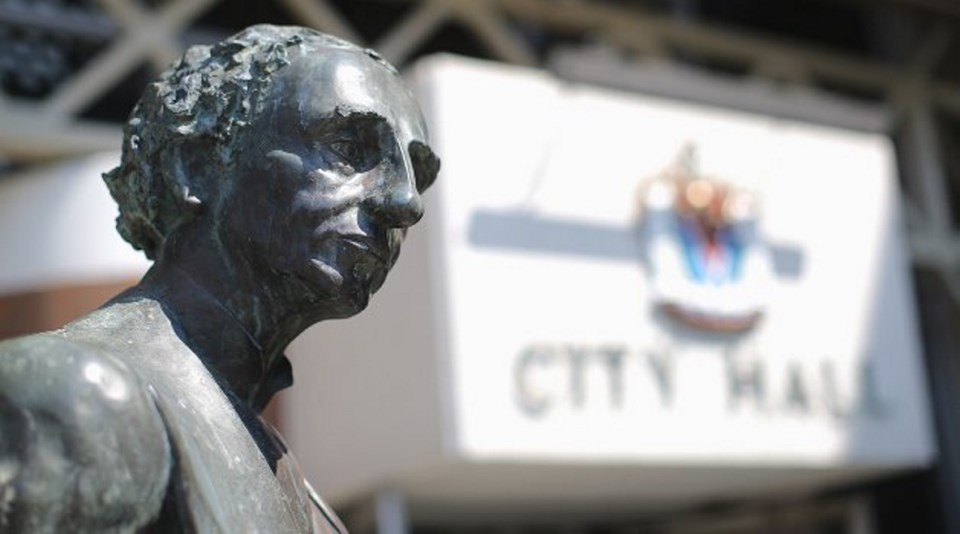The statue of Sir John A. Macdonald, Canada’s first prime minister, will be removed from the Pandora Avenue entrance to Victoria City Hall on Saturday, says Mayor Lisa Helps.
The move stems from the city’s reconciliation program involving local First Nations.
Helps said a key part of reaching a decision on the statue was creating a “city family” to discuss the issue, rather than a formal task force. The group includes Helps, councillors Charlayne Thornton-Joe and Marianne Alto, and members of the Esquimalt and Songhees Nations.
Group members were asked by city council to come up with a course of action for dealing with the statue, erected in 1982.
“The family has made a decision that the statue will be removed,” Helps said.
Their decision will go to city council for approval today, she said.
“All council is being asked to do is to endorse the family’s decision,” Helps said.
“So it’s been a year of deliberation, and it feels like if we really are sincere about reconciliation, we need to remove the statue, put it safely in storage and have a continued and larger conversation about the complex role that John. A. Macdonald played in Canadian history.”
Macdonald, Victoria MP from 1878 to 1882, was the “architect” of the residential-school system, she said. It is “very unlikely” council would oppose the decision that has been made, Helps said. “I would find it very odd and troublesome, and I don’t anticipate that happening.”
Bruce Hallsor, a Victoria lawyer, said it should be noted that the Macdonald statue was paid for and donated by the Sir John A. Macdonald Society of B.C., a citizens’ group. Members originally wanted it to be at the Inner Harbour, he said.
He said that at the very least, the city should be consulting the society about what happens with the statue.
“I think we should be very careful about erasing our history,” Hallsor said. “And we should be very careful about what messages we are sending to people and society when we do so.”
He said that Macdonald is clearly not a person without controversy, but stands as an important figure.
“He was obviously instrumental in the creation of Canada, and whatever his faults were, I think history generally regards him as being fairly liberal for his time with respect to a number of issues.”
Hallsor said he would like to see public debate about the statue before “precipitous” action is taken. “I’m saddened and a little bit ashamed that our city council has slapped history in the face in this way.”
Plans call for a plaque, with wording crafted by the city family, to be put in the statue’s place. It will say: “In 2017, the City of Victoria began a journey of Truth and Reconciliation with the Lekwungen peoples, the Songhees and Esquimalt Nations, on whose territories the city stands.”
Songhees and Esquimalt elders will likely hold a cleansing, blessing and healing ceremony at the statue’s spot. A piece of art depicting Lekwungen culture might replace the statue.
Chief Bob Chamberlin, vice-president of the Union of B.C. Indian Chiefs, applauded the plan to take the statue down.
“When I think of John A. Macdonald and I think of the place in history that he has with Canada, it’s often a very bright light,” he said. “But he was the one who started the residential schools, and there is nothing about education that was part of that package.
“It was about destroying the Indian and the child. It was about destroying our families and our communities, and, of course, however right they might have thought they were in the day, today we understand these as just horrific goals.”
Chamberlin said there was “a very, very awful, racist approach” in the development of the country. “As a First Nations person, the majority of my family went through residential schools.”
Helps said she is a student of Canadian history with a partially completed PhD, and feels embarrassed that until she got involved in the city’s reconciliation program she didn’t understand the scope of Macdonald’s part in establishing residential schools. “We would store the statue safely until, through this continued process of truth-telling and reconciliation, we could figure out a way to tell a broader story rather than having the statue placed out of context on the steps of Victoria City Hall.”
Victoria council has also debated renaming Trutch Street. It was named for Joseph Trutch, a former lieutenant governor of B.C. known for having racist views and treating First Nations people poorly.
Other city councils have recently responded to concerns about historical figures. In Calgary, for example, Langevin Bridge became Reconciliation Bridge. It had been named after Sir Hector-Louis Langevin, a member of Macdonald’s government, and also an architect of the residential schools system.
jwbell@timescolonist.com



